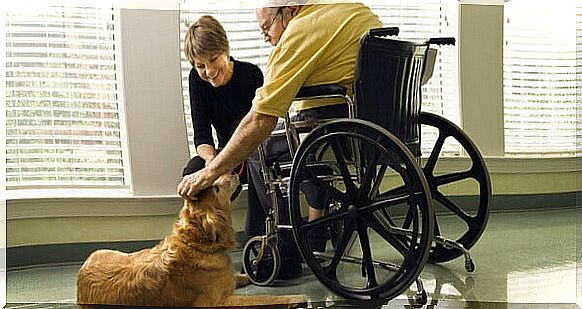Dog Therapy: What Are Its Benefits?

The dog is the pet par excellence. No matter what happened or what your day at work was like, they will always be waiting for you. But, in addition to this loyalty, the use of therapy with dogs as a therapeutic resource has become an increasingly common practice.
This type of therapy is used to help people with disabilities, Alzheimer’s disease, depression and even autistic children. Dog therapy has several physical, psychological and social benefits.
For whom is dog therapy indicated?
Dogs are the most used animals in animal therapies. They are proven to help improve the health and well-being of patients. This type of therapy is based on care and interventions in which the interaction between the animal and the person is introduced as a key point.
It is important to understand it as a complement to clinical therapies, not as a substitute or alternative to other conventional treatments. It must be supervised and directed by health or education professionals. Interdisciplinary work is needed to obtain the expected results.
This type of therapy has been used very successfully to treat people suffering from different problems. Among them, emotional and behavioral disorders such as ADHD, stress, anxiety or depression; addictions or psychological and neurological changes, such as Alzheimer’s disease. And also for autistic spectrum disorders, venereal diseases like AIDS or with dependent and elderly people.

Two types of therapist dogs
Dogs used in these therapies must meet a number of specific criteria or characteristics. It is convenient for them to be agile, active, obedient, affectionate, patient and kind. Once passed through this initial filter, they can be trained as therapist dogs.
We must differentiate two types of dogs, depending on the purpose of therapy:
- Assistance dogs: are prepared to help people with specific needs. For example, guide dogs for the blind, those who help deaf people or who become a support for people with physical disabilities.
- Therapy dogs: are those who become helpers or “co-therapists”. They are used to achieve greater interaction with patients. His work focuses on elderly people, autistic children or individuals with other types of psychological disorders.
There are many psychological and emotional benefits
In people with acquired brain damage, therapy with dogs is very helpful as they increase their motivation. As a method to accelerate your rehabilitation, interacting with these animals serves as an incentive and as a way to stay active. Feeding them or doing activities with the dogs stimulates them mentally. This, in turn, makes them improve their attention and strive to keep up with the pace set.
Therapy also keeps them from feeling lonely. Dogs are considered man’s best friends because they accept us without conditions. That’s why they are a kind of natural therapist, serving as an antidote to combat anxiety, depression, stress, or monotony.
Patients enjoy your company, especially if they like animals. Usually they prefer to recover with another living being rather than a fully mechanical exercise machine.
Furthermore, the bond created between the dog and the person goes beyond mutual affection. Many consider it to be similar to the bond generated by the mother with her baby. As a result of all these benefits, therapy with dogs improves patients’ mood.
Physical and social benefits
Dog therapy increases patients’ physical activity. Playing with them, doing bending or walking activities strengthens muscles, bones and joints. Thus, it facilitates a better development of the vestibular system (related to balance and spatial control), increases proprioception (postural balance) and muscle strength.
On the other hand, it improves motor skills and coordination, because it works all the patient’s senses, from sight, hearing or touch. Also thanks to activities such as stroking, feeding, caring or brushing their hair, the patient acquires a greater command of specific movements, especially of the hands and arms.
Therefore, in addition to being a powerful communication bridge between the therapist and the patient, therapy with dogs provides learning through play. It encourages social contact and the development of leisure skills, improves multiple skills such as empathy, respect, communication, cooperation and teamwork.

Its big advantage: versatility
Dog therapy can be done both in groups and individually. It depends on the needs of each patient and the most appropriate way to address the person’s disability, disorder or difficulty. Compared to other therapies that can only be performed in a specialized center, these can also be done at home. Personalized therapy can be aimed at people of any age, from children to the elderly.
In addition to being one of the favorite pets of children and adults, dogs give us real possibilities for healing. Using them as a complement to therapy offers, as we have seen, multiple benefits at all levels. This means that they are increasingly incorporated into therapies to help and assist problems with changes and disabilities.








